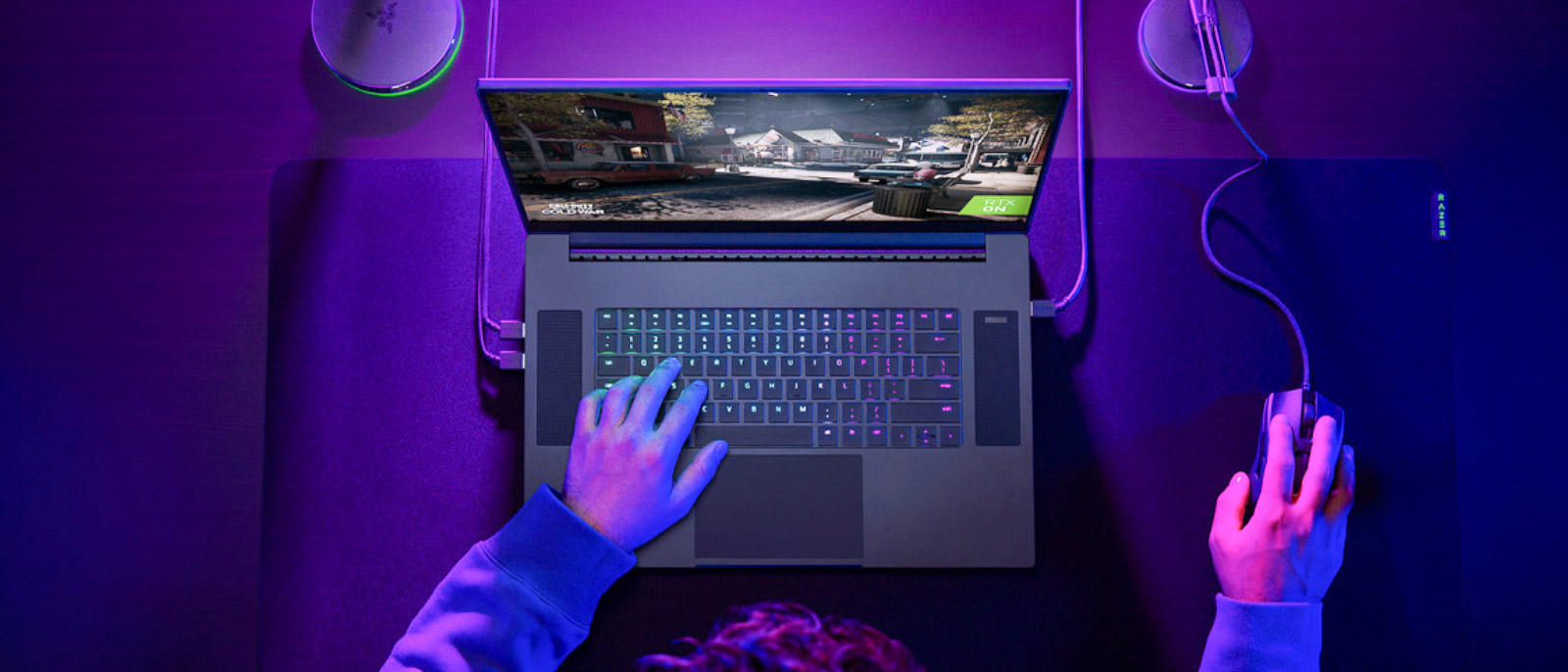Tom's Guide Verdict
The Razer Blade 17 is a premium gaming laptop at a premium price. You can expect excellent performance, a great OLED display and a sleek design, but also a heavy chassis and a relatively cramped keyboard.
Pros
- +
Powerful components
- +
Excellent performance
- +
Gorgeous OLED screen
Cons
- -
Very expensive
- -
Cramped keyboard
- -
Limited battery life
Why you can trust Tom's Guide
CPU: Intel Core i9-11900H
GPU: Nvidia GeForce RTX 3080
Display: 17.3", 4K OLED, 120 Hz
RAM: 32 GB
Storage: 1 TB SSD
Dimensions: 15.6 x 10.2 x 0.8 inches
Weight: 6.1 pounds
The Razer Blade 17 (2021) is one of the most powerful gaming laptops you can buy— and it’s priced to match. The absolute cheapest model will set you back $2,400, and the one we reviewed costs a whopping $3,700.
The latest version of the Blade 17 has a lot going for it, including an Nvidia GeForce RTX 3080 GPU, 32GB of RAM, and a 1TB SSD. You’ll also find an impressive 120Hz OLED display and a generous amount of ports. The Blade 17 could conceivably be your primary gaming and productivity machine for years to come, as it can live comfortably on top of a desk, or in a hotel room, or in a tournament hall.
Still, for such an expensive machine, the Blade 17 doesn't feel as premium as it could. At more than six pounds, it's fairly heavy, nor is it the thinnest gaming laptop on the market. There's also the cramped membrane keyboard, which feels a little antiquated in an era of streamlined numpads and thin mechanical keys.
Still, Razer's pedigree alone makes the Blade 17 worth a look, and in terms of components, you'll definitely get what you pay for. Read on for our full Razer Blade 17 (2021) review.
Razer Blade 17 (2021) review: Price and configurations
The Razer Blade 17 (2021) comes in seven different configurations, at seven different prices. At the cheapest end, there's a $2,400 model, which comes with an Intel i7-11800H CPU, an Nvidia GeForce RTX 3060 GPU, 16 GB RAM, a 1 TB SSD and a 1440p, 165 Hz screen.
The highest-end model, which we reviewed, costs $3,700 and comes with an Intel i9-11900H CPU, an Nvidia GeForce RTX 3080 RTX GPU, 32 GB RAM, a 1 TB SSD and a 4K OLED touchscreen with a 120 Hz refresh rate.
It's worth pointing out that a few models in the middle offer 1080p, 360 Hz screens to maximize frame rate rather than resolution. The middle-of-the-road $2,800 model comes with an Intel i7-11800H CPU, an Nvidia GeForce RTX 3070 GPU, 16 GB RAM and a 1 TB SSD.
The bottom line is that while the Razer Blade 17 comes in a variety of configurations, they can get pretty expensive, pretty quickly. Take a look at our Razer promo codes to see if you can lower the cost.
Razer Blade 17 (2021) review: Design
The first thing I noticed about the Razer Blade 17 is that it weighs a lot: 6.1 pounds. That's heavier than competing 17-inch models from MSI and Alienware, which tend to weigh between 5 and 5.5 pounds.
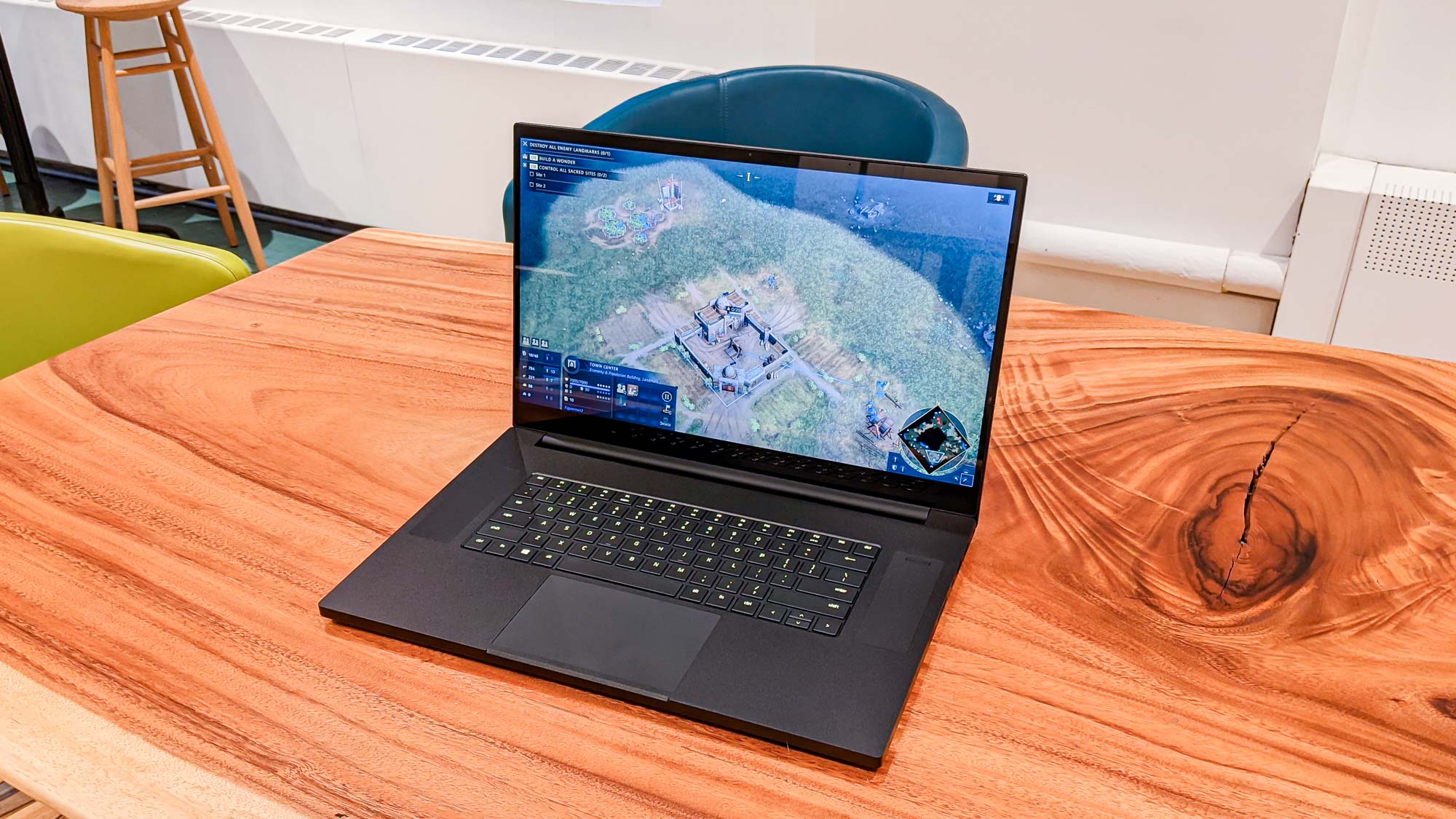
At 15.6 x 10.2 x 0.8 inches, it's thinner than competing laptops from Alienware, but thicker than MSI and other Razer models. It fit in a standard commuter backpack, albeit just barely, and it was a real pain to carry around for more than about an hour at a time.
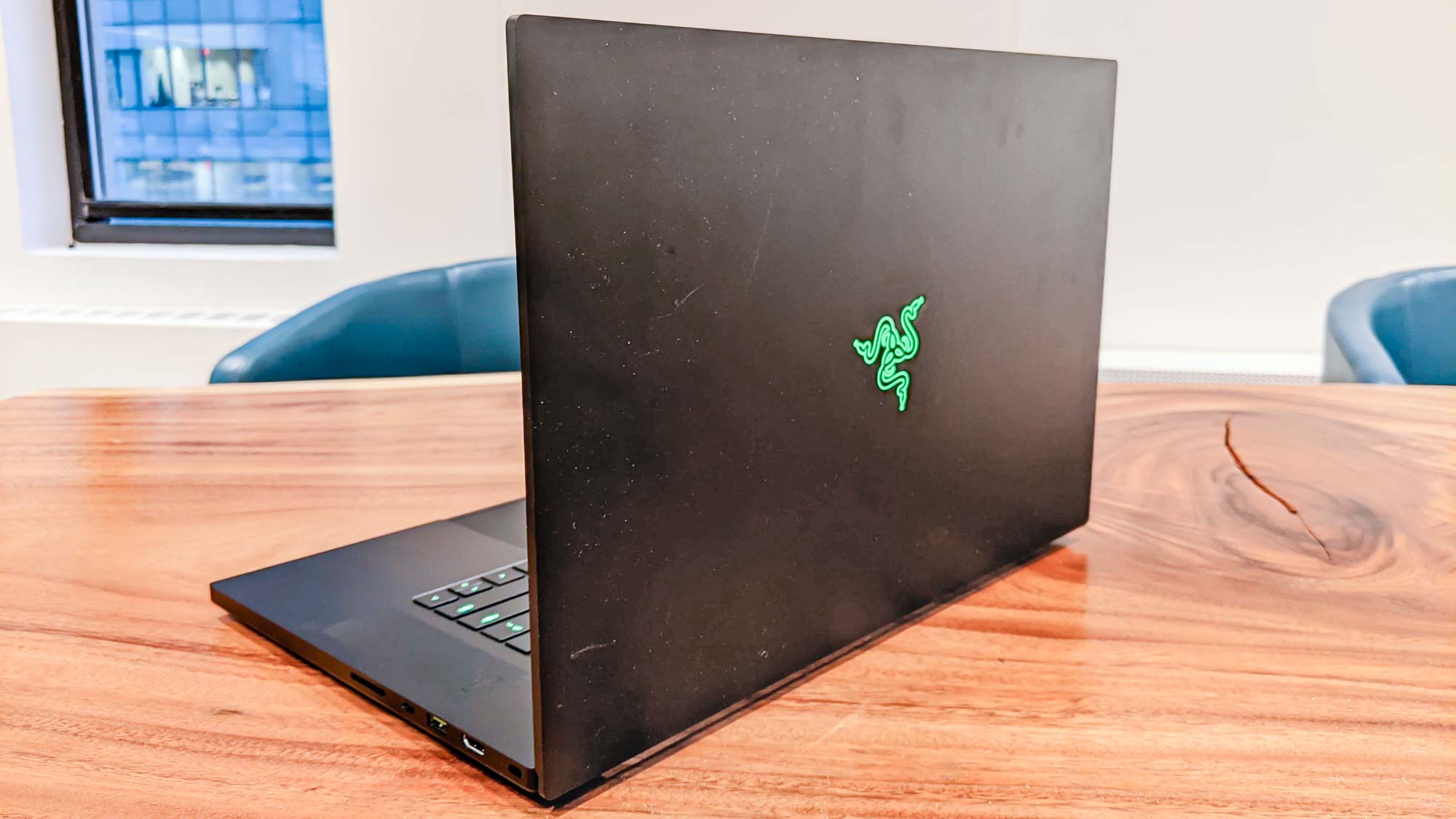
In terms of aesthetics, the Blade 17 has a sleek and straightforward design, much like Razer's other laptops. The chassis is almost all black metal, save for a light-up green logo on top of the lid. The bottom of the laptop has a few ventilation ports, while you'll find a fairly generous selection of ports on the sides.
Razer Blade 17 (2021) review: Ports
The Blade 17 has a generous port selection. Every model of the Blade 17 comes with three USB-A ports, two Thunderbolt USB-C ports, an Ethernet port, a power port, an HDMI port and an SD card reader. This is a robust lineup of ports for both work and play, and having both USB-C and discrete power ports gives you a lot of leeway in the cables you carry with you.
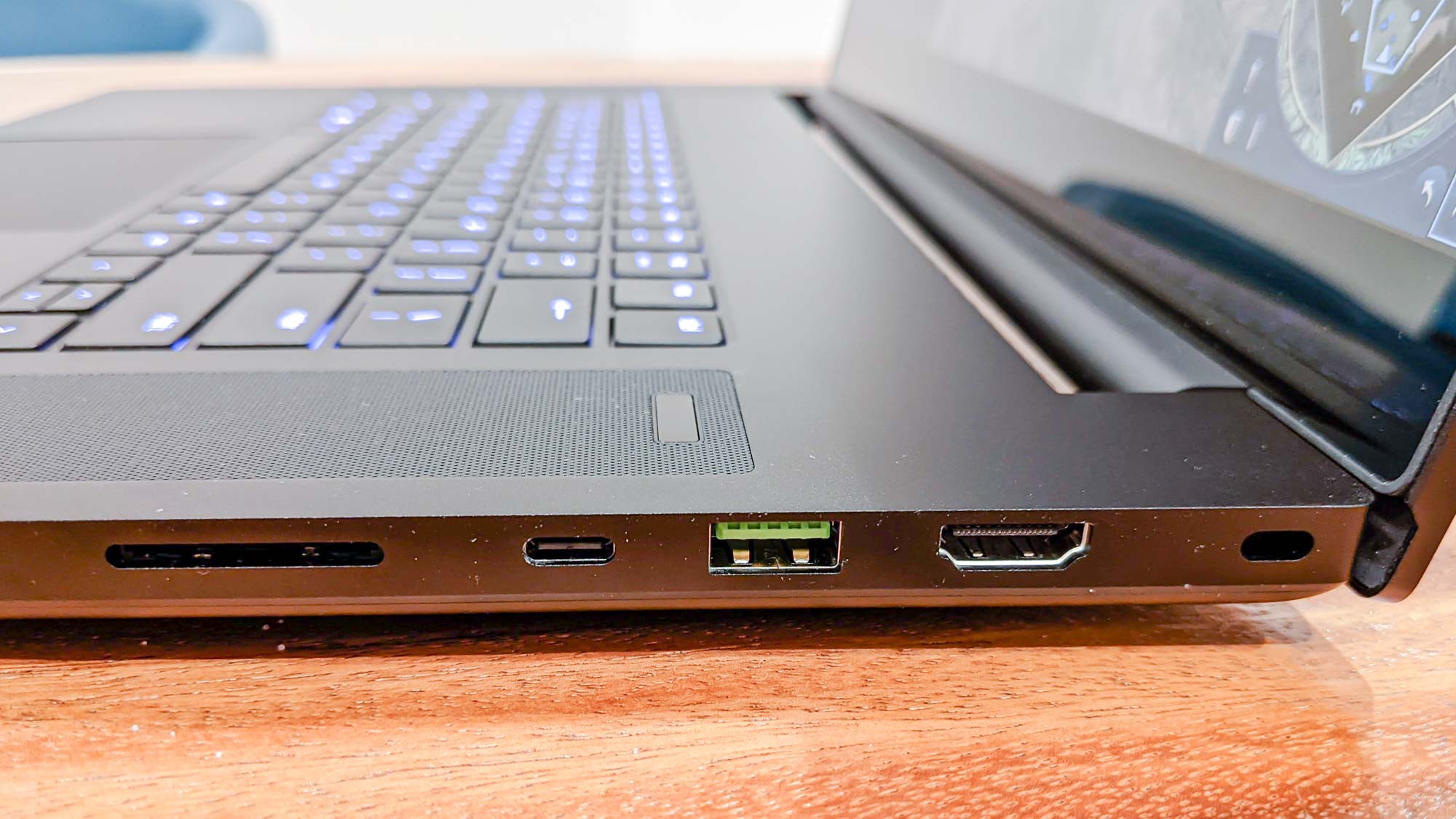
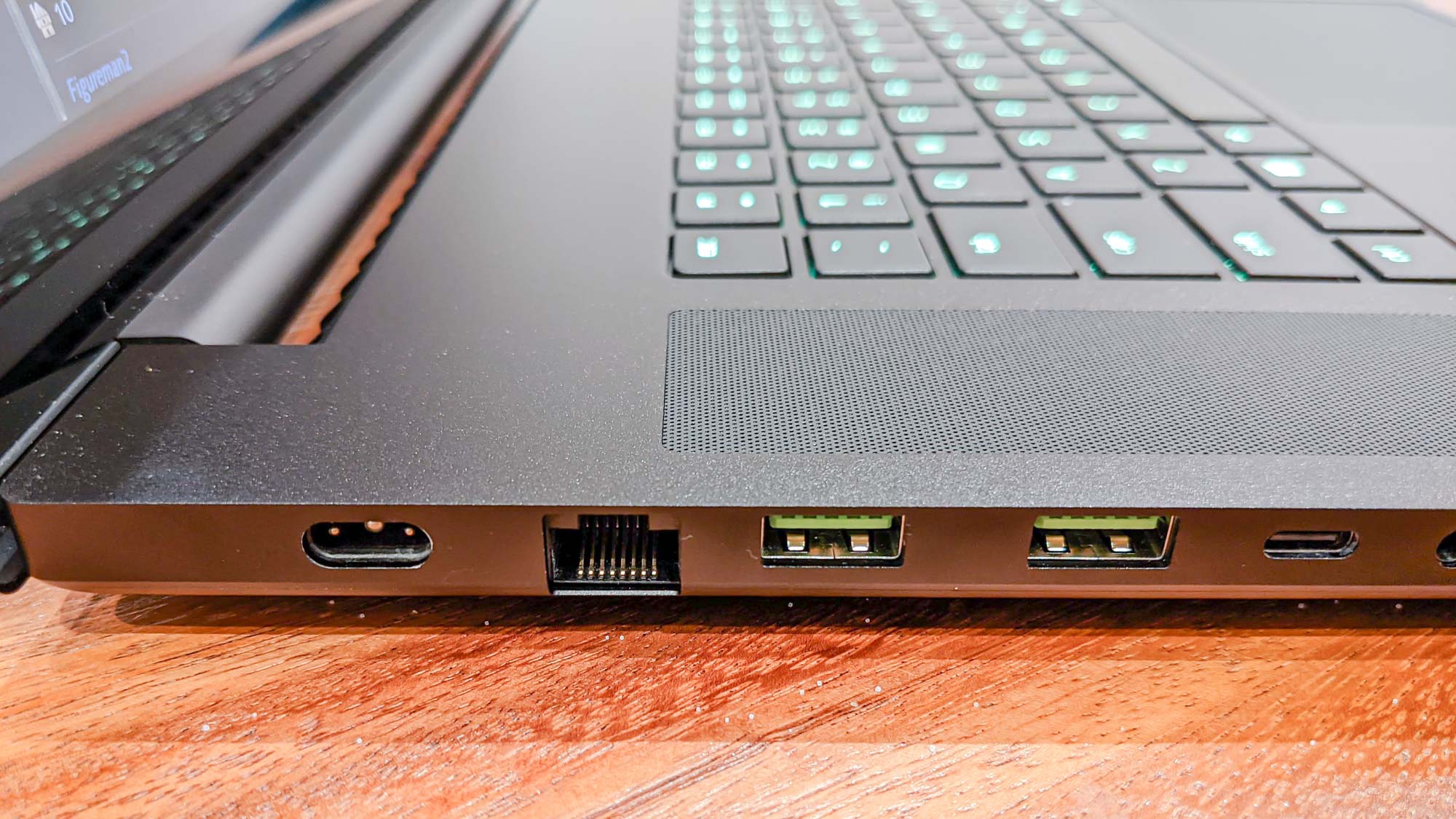
My only issue here is that large USB-C dongles will block the USB-A ports. It's not a Razer-exclusive issue by any means, but it's an increasingly frequent problem in gaming laptops, as peripheral manufacturers start to switch over from USB-A.
Razer Blade 17 (2021) review: Keyboard and touchpad
My one big complaint with the Razer Blade 17 is that the keyboard feels tiny and cramped — which it didn't have to be, considering how much space the speakers take up on either side of it.
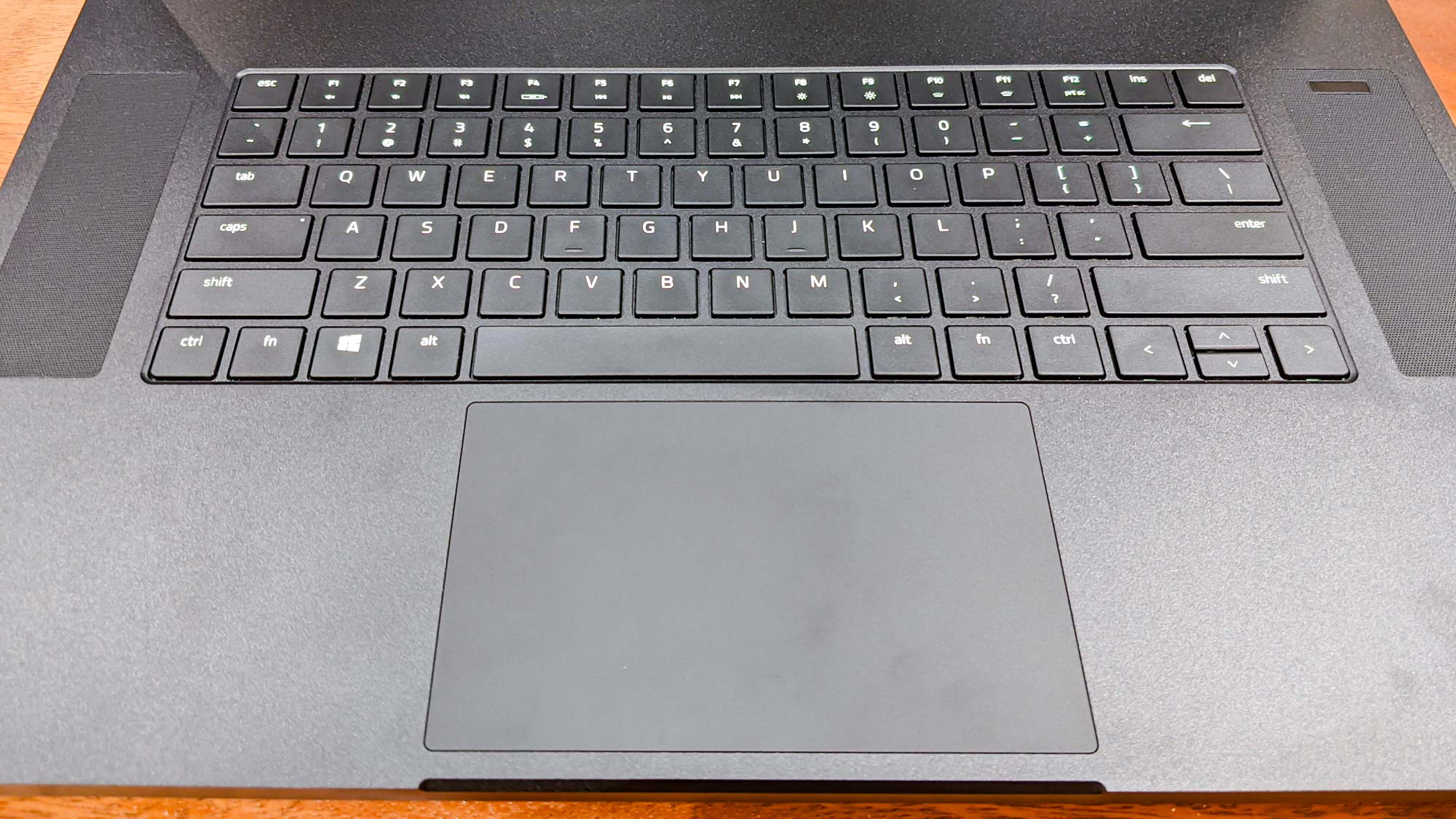
While larger-than-average laptop speakers can be situationally useful, I would have much rather had a numpad, or at least a little more space between keys. Typos were common, and the half-sized up-and down-arrow keys made matters even more complicated. I did appreciate that the keyboard has full RGB capability through the Razer Synapse software, though.
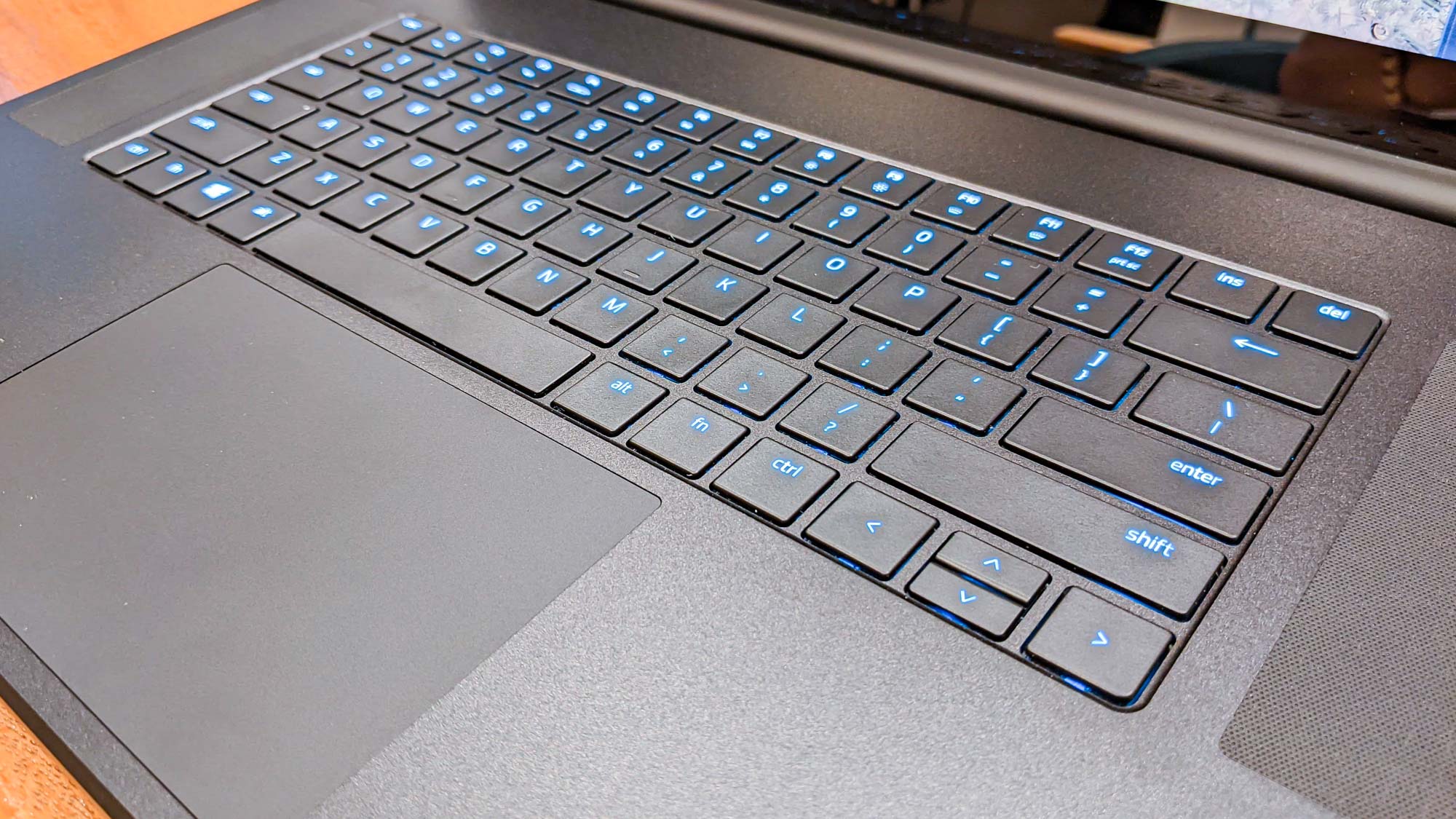
The touchpad, on the other hand, felt responsive, and didn't get in the way too often. I'd still recommend a discrete mouse if you want to get any serious gaming done. Touch typists might actually consider a wireless travel keyboard, too.
Razer Blade 17 (2021) review: Display
The screen in our Razer Blade 17 was the primary reason why I was excited to test it. After running the 4K OLED touchscreen through a gauntlet of games, TV shows and productivity tools, I didn't want to go back to a standard LCD model. Granted, not every model of the Blade 17 comes with a 4K OLED screen, and our Razer Blade 15 Advanced review might give you a better idea of what Razer's more traditional screens look like.
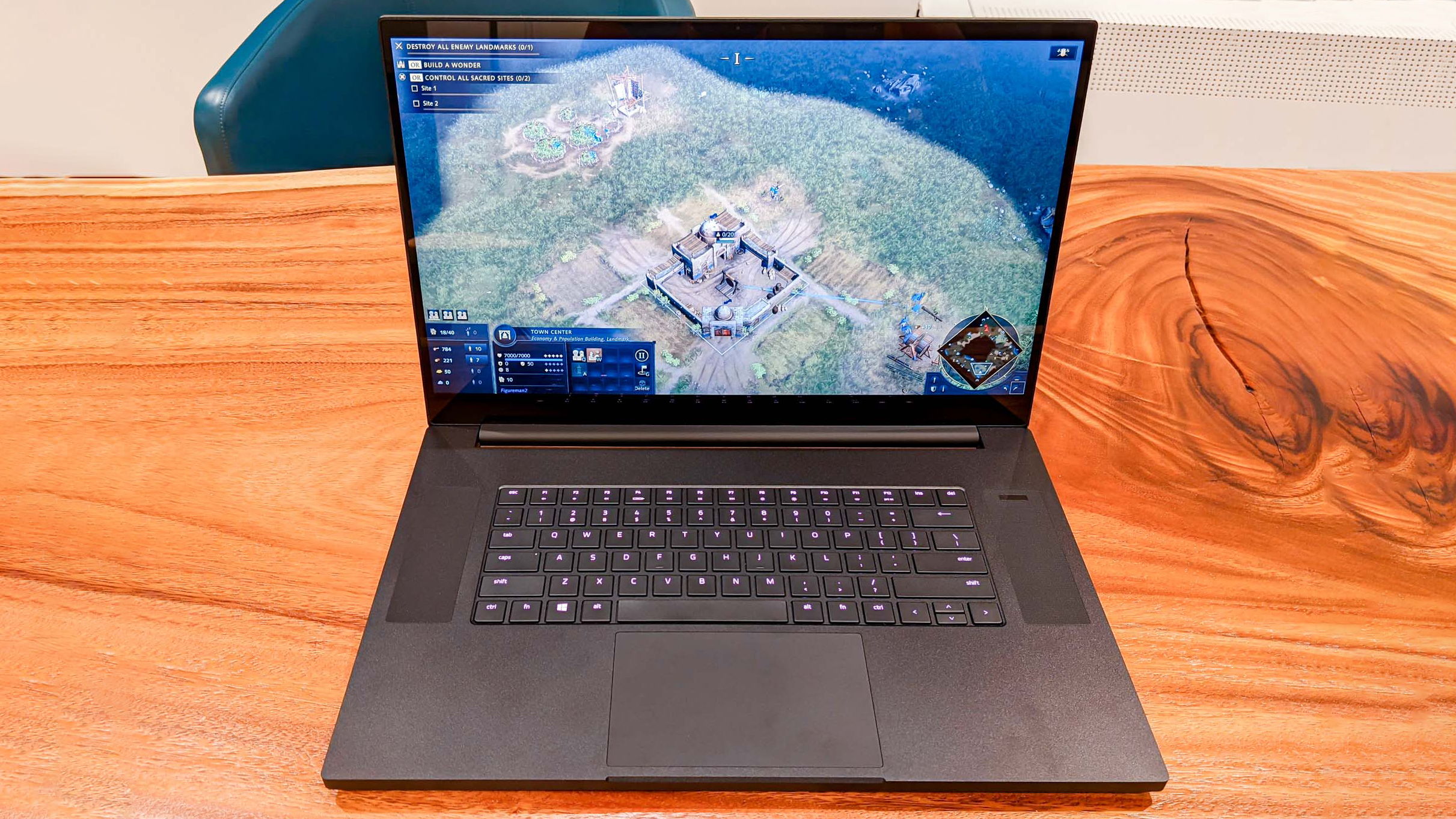
Still, it's hard to overstate just how deep the blacks and just how vibrant the colors look on a UHD OLED screen, and it's especially striking when playing games that lean heavily into a cohesive color palette, such as Doom Eternal's red and browns, or Age of Empires IV's blues and greens. We ran the numbers, which back up our observations:
| Row 0 - Cell 0 | Razer Blade 17 | Maingear Vector Pro | Razer Blade 15 Advanced |
| Brightness (nits) | 349 | 346 | 313 |
| sRGB Color Gamut (%) | 113 | 114 | 109 |
| Delta-E | 0.25 | 0.20 | 0.24 |
Compared against the similarly powerful Maingear Vector Pro and Razer's other heavy hitter, the Razer Blade Advanced 15, the Blade 17 more than holds its own, offering the best brightness of the three, and a better coverage of the sRGB spectrum than the Blade 15.
Granted, the Blade 17 is not quite as colorful as the Vector Pro, or as color-accurate as either machine (a lower delta-E means better color accuracy), but there's not a tremendous difference in benchmarks. The bigger difference is qualitative: an OLED screen simply looks better most of the time, particularly for dark images that require subtle contrast.
It's hard to overstate just how deep the blacks and just how vibrant the colors look on this 4K OLED screen.
With a 120 Hz screen, the Blade 17 is also perfectly poised to run games at 4K settings. While running 4K games at 120 fps sounds like a dream come true, gaming laptops aren't quite ready to do that yet — the absolute best we got were brief bursts of Final Fantasy XIV at 115 fps. You won't need to worry about the machine's performance outstripping its refresh rate.
Razer Blade 17 (2021) review: Gaming performance
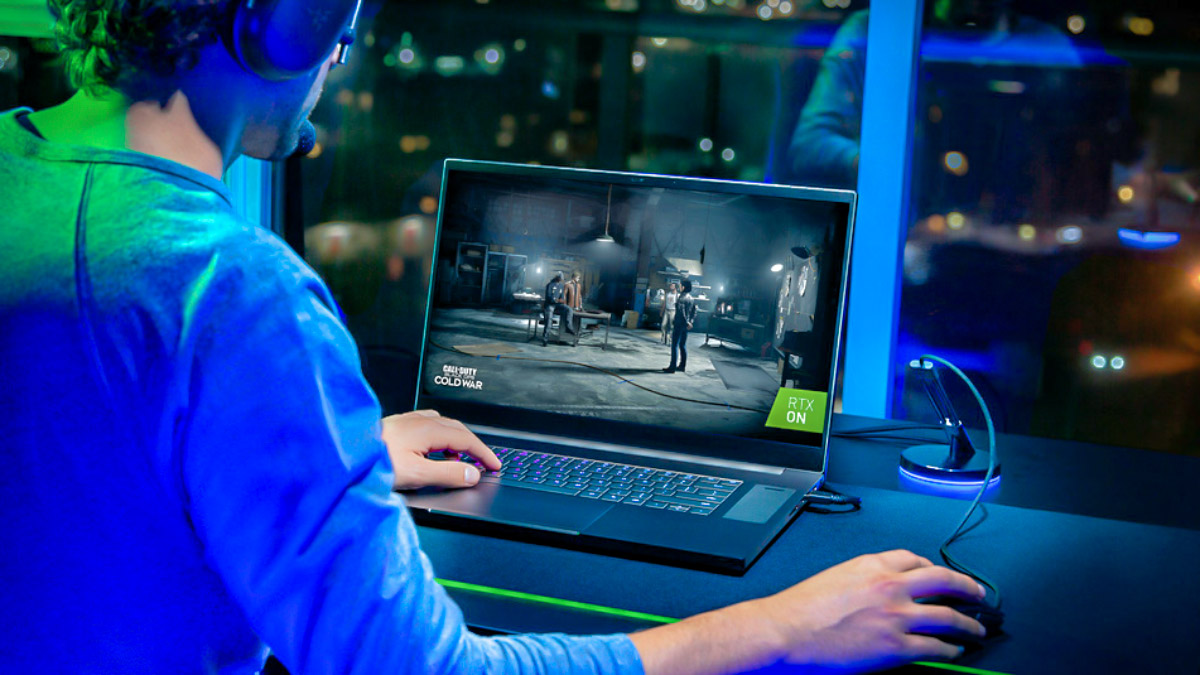
Generally speaking, the Razer Blade 17 generally provides better performance than other gaming laptops we've tested recently. This seems fitting, since the Blade 17 is also much more expensive than those other laptops. Take a look at some frame rate benchmarks in common games, measured in frames per second (fps) at 1080p resolution:
| Row 0 - Cell 0 | Razer Blade 17 | Maingear Vector Pro | Razer Blade 15 Advanced |
| Assassin's Creed Valhalla | 80 | 74 | 66 |
| Dirt 5 | 91 | 89 | 78 |
| Grand Theft Auto V | 111 | 124 | 106 |
| Shadow of the Tomb Raider | 81 | 93 | 82 |
In Assassin's Creed Valhalla and Dirt 5, the Blade 17 performed better across the board. In Grand Theft Auto V and Shadow of the Tomb Raider, however, the Blade 17's performance was a bit more mixed, falling considerably short of the Maingear Vector Pro. This could be due to a difference in drivers, or it could be that the Blade 17 is simply not optimized for lower resolutions.
That brings us to another important point: the Blade 17 has a full 4K screen, which is a relative rarity among gaming laptops. At 4K settings with the graphical options cranked up to Nvidia-recommended settings, Assassin's Creed Valhalla ran at 38 fps; Dirt 5 ran at 48 fps; Grand Theft Auto V ran at 35 fps; and Shadow of the Tomb Raider ran at 33 fps. These are all comfortably above 30 fps, which is generally the minimum frame rate you'd want for a modern game.
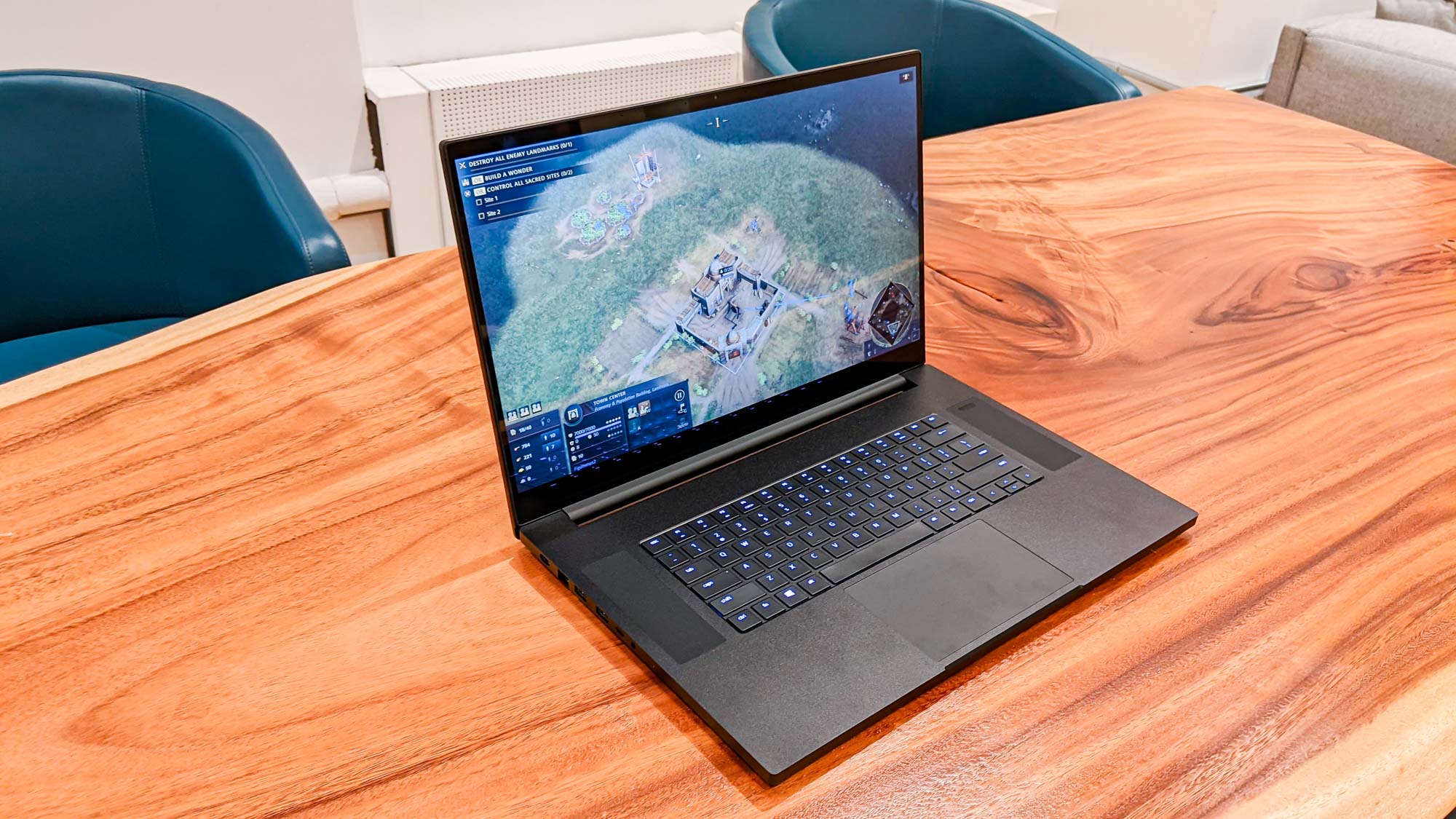
You can also toy with the settings if you'd prefer true 4K/60 fps gaming, which I was able to achieve in a number of titles. Age of Empires IV, Dragon's Dogma: Dark Arisen and Final Fantasy XIV all ran around a consistent 60 fps at 4K, even during intense battle scenes. Only Doom Eternal hovered around the 35 fps range — but even then, 35 fps at 4K is nothing to sneeze at.
Razer Blade 17 (2021) review: Productivity performance
In terms of productivity performance, the Razer Blade 17 wasn't the benchmarking powerhouse that I expected.
| Row 0 - Cell 0 | Razer Blade 17 | Maingear Vector Pro | Razer Blade 15 Advanced |
| Geekbench 5.4 (artificial performance benchmark) | 7,010 | 8,786 | 6,924 |
| Copying 25 GB from flash drive (MBps) | 1,247 | 1,844 | 1,796 |
| Handbrake video encoding (minutes:seconds) | 8:59 | 6:27 | 8:46 |
Using the artificial Geekbench 5.4 test, which gauges a machine's overall power, the Blade 17 fell short of the Vector Pro, and exceeded the Blade 15 Advanced only slightly. Both the Vector Pro and the Blade 15 advanced outperformed the Blade 17 in the file-copying and video-encoding tests, often by a wide margin. The Blade 17's terrific components don't always turn in the level of performance I had expected.
On the other hand, this may not matter much from a practical standpoint. I used the Blade 17 as my everyday workstation for about a week, and it handled everything I could throw at it, regardless of how many tabs I had open, how many programs I had running or how much multimedia I wanted to consume. This is probably due to its 32 GB RAM, which far exceeds what an everyday worker would need — unless, of course, your everyday work involves graphic design or animation.
Razer Blade 17 (2021) review: Battery life and heat
The Razer Blade 17 runs hot, and has a surprisingly short battery life, for both productivity and gaming. Here's how it compares:
| Row 0 - Cell 0 | Razer Blade 17 | Maingear Vector Pro | Razer Blade 15 Advanced |
| Battery life – productivity (minutes:seconds)Valhalla | 3:52 | 6:27 | 5:23 |
| Battery life – gaming (minutes:seconds) | 1:19 | 1:37 | 1:35 |
| Heat – productivity (°F) | 108 | 104 | 88 |
| Heat – gaming (°F) | 123 | 129 | 123 |
Even if you use it for productivity, the Blade 17 is too hot to comfortably keep in your lap. While you're gaming, you probably won't want to touch the underside at all.

At less than four hours, the battery life is also relatively unimpressive; it won't even last for a moderately long flight. While the Blade 17's gaming heat and gaming battery life are comparable to the other laptops we tested, the other systems last much longer for productivity, and the Blade 15 Advanced is cool enough to hold in your lap if you're not gaming.
Razer Blade 17 (2021) review: Verdict
The Razer Blade 17 provides excellent performance and gorgeous visuals, albeit for a lot of money. In terms of performance, it's similar to its close competitors — although said competitors don't offer full 4K screens, so you'll have to take that into account.
If you're in the market for a powerful 17-inch gaming laptop, the Alienware m17 R4 is also worth considering, as is the Maingear Vector Pro. But there's something undeniably stylish about the Razer Blade 17's design, and you'll get good performance for both work and play.
Marshall Honorof is a senior editor for Tom's Guide, overseeing the site's coverage of gaming hardware and software. He comes from a science writing background, having studied paleomammalogy, biological anthropology, and the history of science and technology. After hours, you can find him practicing taekwondo or doing deep dives on classic sci-fi.
